|
|
 |
 |
Yak SOF and Dragon Boats
Hi Chuck,
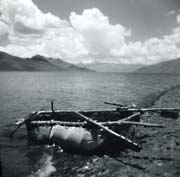 Yak SOF boat
Yak SOF boat |
I was looking for something else this morning, and stumbled across the photo of the Yak S-O-F boat and figured some folks would get a kick out of it and scanned it in. It was taken in Tibet in 1995 and the lake is called Namtso or "Heaven Lake", the highest salt water lake in the world at about 15,500 feet (4,700 meters). No idea what the boat was used for -- no other people around for miles, though there are fish in the lake and a couple of islands that pilgrims go to. Interesting boat I thought -- the wood, as you can see from the photos, was hauled up from lower altitudes. Yak skin covering and lacing to hold it all together, I would guess yak fat to protect the skin, and quite a bit of tumblehome.
Then, as I had the scanner out and was in the mood, I hunted up some dragon boat photos I took in Cambodia later that year (what made me think of them were a couple of posts talking about dragon boats on the Yahoo forum). They were taken in late November during the Water Festival on the Tonle Sap river in Phnom Penh. The river is fed by a large lake about 75 miles north of Phnom Penh, and actually flows uphill for a large chunk of the year. During the wet season, the Mekong River rises, and as there is only (as I remember) 10 feet or so of difference in elevation between the lake and Phnom Penh, as the Mekong rises, it forces water back up the channel and the Tonle Sap lake grows by about 6 times, flooding about 1/4 of the country. Then as the Mekong falls in the spring, the water reverses. The Water Festival marks the day, more or less, when the river's flow turns back into the Mekong and the sea. This is important for Cambodia, because the fish from the lake are trapped and netted at this time, providing most of the country's protein for the year. They take many of the fish, gut and scale them, then grind them up and pack them in big (6'x6'x4') woven bamboo baskets and let them ferment. The fish "cheese" is then packed in jars with lots of salt and can keep for years and is mostly used to flavor soups and sauces. In small quantities, as a seasoning, it is really good, but I remember riding north out of the city sometimes in the cheese season, and man, the smell, even in the open air, could fell a water buffalo.
 |
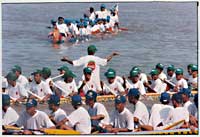
Dragon Boats
(click images for larger views) |
At the time, the dragon boats used in this race were essentially dugouts, made from a single tree, though very often the sides were flared out and a strake or two of planking added for more freeboard. I remember the last year I was there, a team from Singapore, I think, turned up with a fiberglass boat, but was not allowed to race in it.
Cheers, Brian Anderson
|
 |
Jarcat
One of the all time success stories of Australian Multihulls has been Ross Turner, who actually cracked the non-demountable cruising cat problem with his Jarcat designs a decade and a half ago.
https://www.members.optusnet.com.au/rhturner1/

He has had hundreds of boats to his different designs built. Designs range from 5m (16ft) to 32ft
The construction uses the deck as a flat to build the structure on - the structures are light, using thinner ply than most are used to but have proved to be extremely robust over hundreds of boats and tens of thousands of cruised miles.

Because the boats are light and effective structures they perform REALLY well.
The number of parts involved in building the boats is small for a catamaran project.
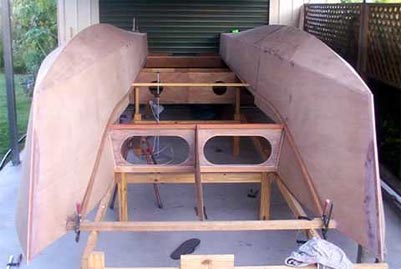
There is a huge amount of innovation that is not obvious - note the mast is stepped behind the cabin - reducing the cabin structure required and eliminating the pesky post that would be in the middle of the cabin. It also means that the mast can be pushed up from the security of the cockpit rather than skating round on some cabin roof.
Also they are light to trail - the 20 footer is 900lbs for an awful lot of interior space. They can be fitted with quite big outboards too - to wakeboarding performance - though this does reduce the sailing performance a bit - but 10hp will give over 10 knots without any trouble at all.
Ross is a good bloke and has been a bit unwell recently - his designs do deserve a lot more profile than he has energy to give them.
Best wishes
Michael Storer
|
 |
Cat
Here are some pictures of a 22' Cat I built.
Mark Gumprecht |
Okie Seafood:
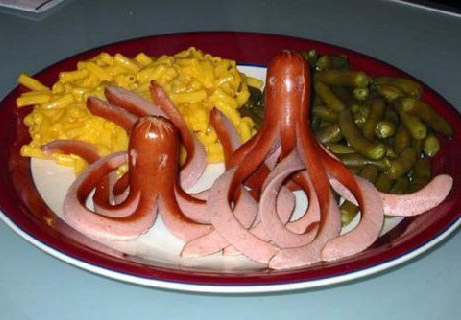
submitted by Ross Miller |
| Core Sound
Hi Chuck
Sorry to be so slow. Here are two pictures of my Core Sound under sail.
Good luck with the Texas 200. It looks like a great crowd. I see that Graham is coming with Southern Skimmer.
Doug Cameron
|
| Pathfinder
Hello Chuck;
I took these pictures of our Pathfinder this morning.
 |
picture 02 shows the bowsprit with two forestay brackets installed. The other bronze fittings are homemade. |
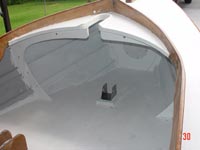 |
Picture 06 is a good shot of the main mast tabernacle. |
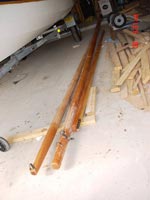 |
Picture 12 is a shot of the main mast, mizzen mast, and main boom. |
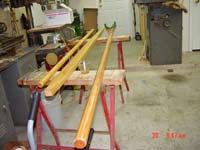 |
Picture 14 shows the gaff, mizzen boom and the boomkin. |
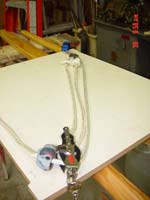 |
Picture 18 is the main sheet. Starting at top-boom strap, swivel snap, [to be changed out with a D ring], single block/becket, [That big knot needs to be spliced into an eye], fiddle block/cam which swivel snaps to an eye on the centercase. |
Regards, Denis Menegaz |
 |
It’s time to take on “Big Water”
This ain’t about sailing, but let it be known that the writer has built three boats, likes to sail and paddle, does so frequently, and will write about that when he gets around to it.
On a recent Memorial Day trip, I was fuming over the price of gasoline I had just pumped into my Toyota. Not the fact that it was at a record high (using actual whole numbers), and not the fact that it had risen simply because people would be taking vacations and forced to buy gas on major traffic routes. I was livid because the price had risen over a dime per gallon at convenience stores that weren’t even open, and I also wanted a bottled water.
I finally found an open store and selected one of the many water offerings to be had, bottled at the source in the South Seas, and drawn from artesian aquifers deep within the islands, probably by native women like you would see in a Paul Gauguin painting. It came in a clear 1 pint plastic bottle like the cheaper sodas, but unlike them, it contained no sugar, natural or manmade ingredients; just water, and had palm fronds printed on it. This mental image of a pristine tropical paradise helped me justify handing over the $1.89 with a smile, actually thanking the cashier.
I have to inject here that although I know Coke and Pepsi produce cheaper water, I find buying Coke water kind of creepy.
As I took the last sip, the part of my brain that had previously been working on the oil prices became refreshed, and the mental image began to change. I began to follow the trail of that water back to the source, and running the numbers, determined I was paying $15.12 per gallon for water…something that required no refinery, no pasteurizing, no bureaucracy of federal beak-dippers to extort hidden fees, and the natives probably shop at the Gap and eat French fries.
I’m no math expert, but that’s dang near 4 times what I’m paying for gas. The state where I live charges over 8 percent sales tax. At 8 percent of $15.12, that means once I’ve bought a gallon of what we used to call “drinking water”, I’ve given up over $1.20 just to the state, but that’s another gripe. There’s still quite a cache of doubloons going to the Fijian water-dippers for a one-gallon bucket of runoff.
When I was very young, there were still “Service Stations” where uniformed attendants pumped your gas, cleaned your window(s), checked and topped your oil, transmission, washer and brake fluid, but one of the best things was that they had a Water Fountain. To a kid who had ridden for 3 hours shirtless in a Ford Falcon Station wagon through Mississippi in the summer, stuck to a vinyl seat by sweat and whatever he had spilled, “Ya’ll go get some water and go to the bathroom” sounded like Gabriel blowing his horn. Even the word “fountain” is refreshing.

Our Falcon wagon had what they called a “box” style air vent under the dash, which allowed air, leaves, and exhaust from the truck you were following to freely flow across the knees of the passenger riding shotgun, the most favored seating position, generally reserved for Mothers. The vinyl seat had little raised longhorn cow emblems that would emboss our backs, and if you shifted around a lot, you could get a whole herd going.
Anyway, after peeling us off the seats, we would like up at the water fountain, knowing that Service Stations always kept their water just next to freezing. Even with the greasy thumbprints and knowing that 10,000 other sweaty people had stuck their gullets up against the chrome cheek-rest, that water was the purest, coldest and most refreshing water that was ever pumped, as I remember it. In any case, we wouldn’t have thought of paying for it anymore than we would have paid for dirt.
A little further down the road as I completed the water’s journey at a rest stop, I reflected that the water’s mileage was about the same as gasoline, although more expensive by the bottle. I decided that I would stop worrying about gas prices and change what I could. So I’m trying to get back to dipping my water cup under the faucet, but after its trip through miles of tanks and pipes, it gets pretty rank, even with the fluoride. I may have to break down and buy one of those filter things; or maybe find me an old Service Station water fountain.
Stacy Smith
The picture of the luxury version Falcon shown here was borrowed off the web. Ours was a bit more basic. |
 |
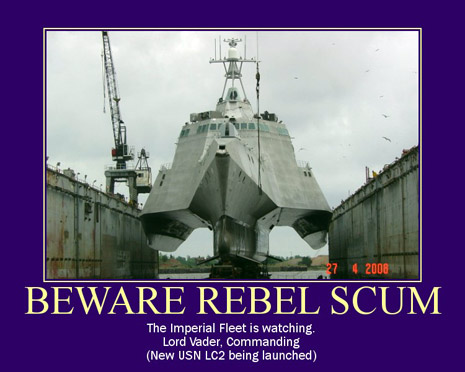
Submitted by Bruce Armstrong |
 |
Drawing Semi Circular Hulls
I have been reading Barend Migchelsen on “Boat Building with a difference”, which I still don’t totally understand. In the process of designing a catamaran I needed to transfer from one paper to another my framing sections. Since I had used splines to round out a curve, I found it difficult to copy (paper little thick) and wondered is there a better way.
Could I give a set of tables that would tell a person exactly how to reconstruct my rounded frames? Maybe without even a set of plans?
Then I took Barend’s idea that I did understand and did the following:
1-Draw a station with the beam and the keel depths marked.
2-Draw a straight line between keel(K) and beam width (BW). You now have a triangle (and in boating circles a Veed hull). (Remember you only need to draw one half of the cross section)
3-Find the middle of line from Keel to Beam width (K to BW) in two parts.
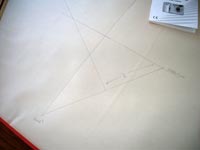
4-From the middle point go up 90 degrees – at least about three times the distance from the centerline to the width of the beam.
5-Unless you have very long compass - get a stick and drill a hole and put a push pin through it. Tack it to the line somewhere around about three times the distance from the centerline of the boat to the outside beam.
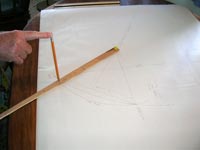
6-Notice the curve above the waterline (expands outward, providing positive flotation).
7-Experiment. The shorter the radii, the rounder the section. However, there is a point when the hull beam at it’s widest point will be under water, and when it meets at the water line, cures inward (which means very little reserve buoyancy)

Now for each section you can make a simple chart:
| Sample |
|
|
|
| Station Number |
Beam Width |
Keel Depth |
Radii |
| 4 |
6” |
9” |
18” |
| 5 |
5-½“ |
8” |
16-1/2” |
| 6 |
3" |
7" |
3” |
Beam width and Keel depth are easy. Radii is the distance measured up from the straight line between the beam width and keel depth places, measuring at the half way point between Beam Width and Keel Depth.
By making the radii shorter or longer you control the fatness of the curve.
I wanted to put in a sacrifice strip on the bottom, so by making off an inch at the keel my new point K is out where the edge of the strip ends – and everything still works from there. Above the water line I will taper into some arbitrary place and get the rest of my freeboard and deck.
Hope this helps out someone.
Now if only someone could tell me how to do an ellipse or parabola as easily.
Alan Berry |
 |
| New Mini Washing Machines & Spin Dryers for Boaters

Compact washing machines as seen in Cruising World, Boating World and More
We have compact, inexpensive washing machines and spin dryers that have been extremely popular with boaters. The washers weigh less than 6 pounds, and are only 12” x 12” x 16.” It washes a 5 lb. load clean in only 1-2 minutes, and uses even less water than hand washing.
You can view independent reviews from Cruising World Magazine, and Boating World.
Other reviews from boating publications can be seen at our website.
Sincerely,
Corey K. Tournet
The Laundry Alternative, Inc.
https://www.laundry-alternative.com
Tel. 888.813.9559
|
|
|

